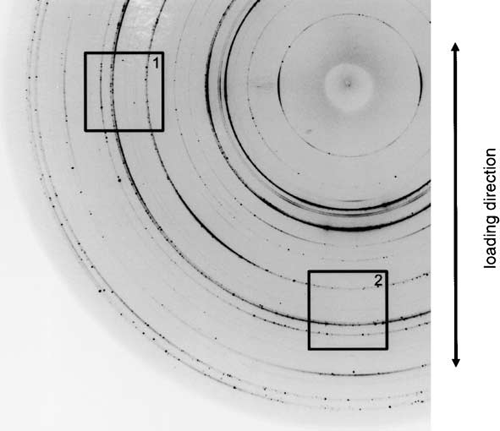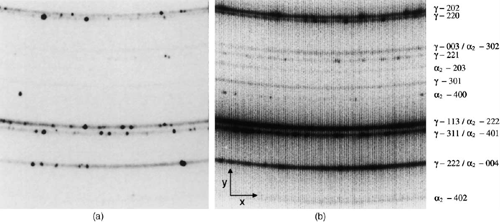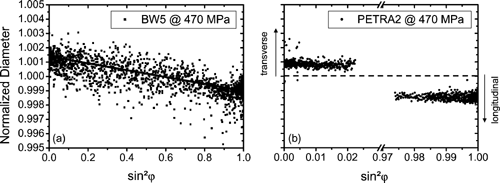Abstract
High-energy X-rays between 30 keV and 1 MeV, such as provided by modern synchrotron radiation sources as the ESRF and HASYLAB, bear the advantage of high penetration into most materials. Even heavy element compositions can be accessed in their volume. The range of applications is huge and spreads from nuclear spectroscopy to the characterization of metal extrusion under industrial conditions. This article compiles an overview over the most common instrumental diffraction techniques.
Modern two-dimensional detectors are used to obtain rapid overviews in reciprocal space. For example, diffuse scattering investigations benefit from the very flat Ewald sphere as compared to low energies, which allow mapping of several Brillouin zones within one single shot. Diffraction profiles from liquids or amorphous materials can be recorded easily. For materials science purposes, whole sets of Debye–Scherrer rings are registered onto the detector, their diameters and eccentricities or their intensity distribution along the rings relating to anisotropic strain or texture measurements, respectively. At this point we stress the resolution of this technique which has to be carefully taken into account when working on a second generation synchrotron source.
Energy-dispersive studies of local residual strain can be studied by a dedicated three-circle diffractometer which allows accurately to adjust the scattering angle from a defined gauge volume.
Triple axis diffractometry and reciprocal space mapping is introduced and can be employed for highest resolution purposes on single crystal characterization, even under heavy and dense sample environments. Thus, the perfection of single crystals can be mapped and strain fields and superstructures as introduced by the modulation from ultrasonic waves into crystals or epitaxially grown Si/Ge layers can be investigated in detail. Phase transitions as magnetic ordering can be studied directly or through its coupling to the crystal lattice. Time resolved studies are performed stroboscopically from a sub-nanosecond to a second time scale.
The combination of these techniques is a strong issue for the construction and development of future instruments.
Acknowledgments
The authors of this review article wish to thank their partners who contributed to the examples presented in the different sections. In particular we appreciate and enjoyed the collaboration with Anke Pyzalla, Thomas Buslaps, Alain Jacques and Olivier Ferry for the energy dispersive results, Alexander Wanner, Jochen Böhm, Reinhard Kampmann, Thomas Lippmann and Hermann Franz for the strain measurements on TiAl, Michael Ohler and Agnes Royer for the crystal quality mapping, Rainer Hock and Andreas Magerl for the ultrasonic measurements and Tapan Chatterji for the works on antiferromagnetic materials. Further we like to thank the teams on ID15/ESRF and BW5/PETRA-II/HASYLAB for their enthusiasm and instrumental support.
Notes
1Model MAR 345 by MAR, Evanston, IL, USA; http://www.marresearch.com/
2DENEX GmbH, Lüneburg, Germany; http://www.denex-gmbh.de/
FIGURE 11 Part of a typical diffraction pattern of the γ-TiAl-based alloy, recorded by the image plate detector at beamline BW5. A close-up of area “1” is shown in . From Böhm et al. (Citation2003).

FIGURE 12 Corresponding diffraction patterns (a) and (b) registered by the image plate detector at beamline BW5 (area ‘‘1’’ of ) and by one of the two wire-frame area detectors at PETRA2, respectively. The reflections are indexed on the right for the phases γ-TiAl and α2-Ti3Al. From Böhm et al. (Citation2003).

FIGURE 13 (a) Example of the strain evaluation procedure based on the full diffraction rings recorded at BW5. The diameter of the γ-TiAl 222 diffraction ring is plotted against sin2 φ, where φ is the azimuthal angle. The diameters are normalized to the average ring diameter in the stress-free starting condition. Due to the lattice strains caused by the applied stress of 470 MPa, the diffraction ring is distorted elliptically. The two main axes of the ellipse are obtained by fitting a straight line to the data and extrapolating to sin2 φ = 1 (longitudinal direction) and sin2 φ = 0 (transverse direction). (b) The same procedure can be applied to the radii of the ring segments recorded at PETRAII. The range of sin2 φ is restricted to values close to 0 and 1. It is apparent that the data in (b) exhibit considerably less scatter than those in (a). From Böhm et al. (Citation2003).

3Crystal Gmbh, Berlin, Germany; http://www.crystal-gmbh.com